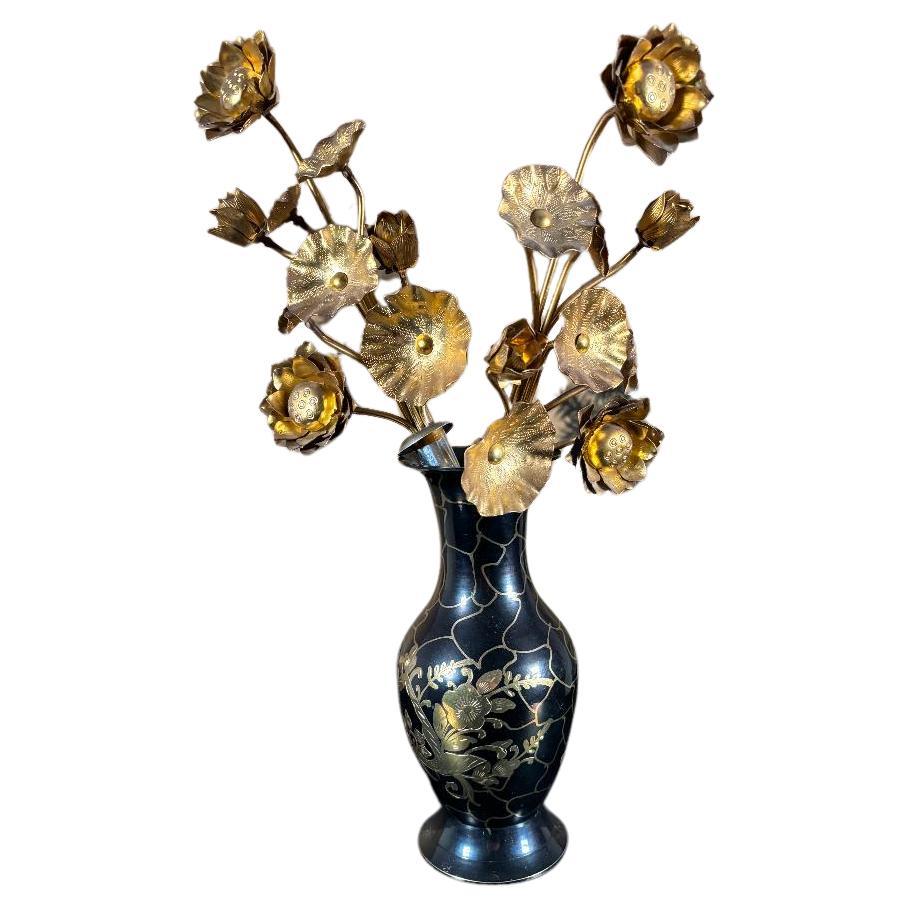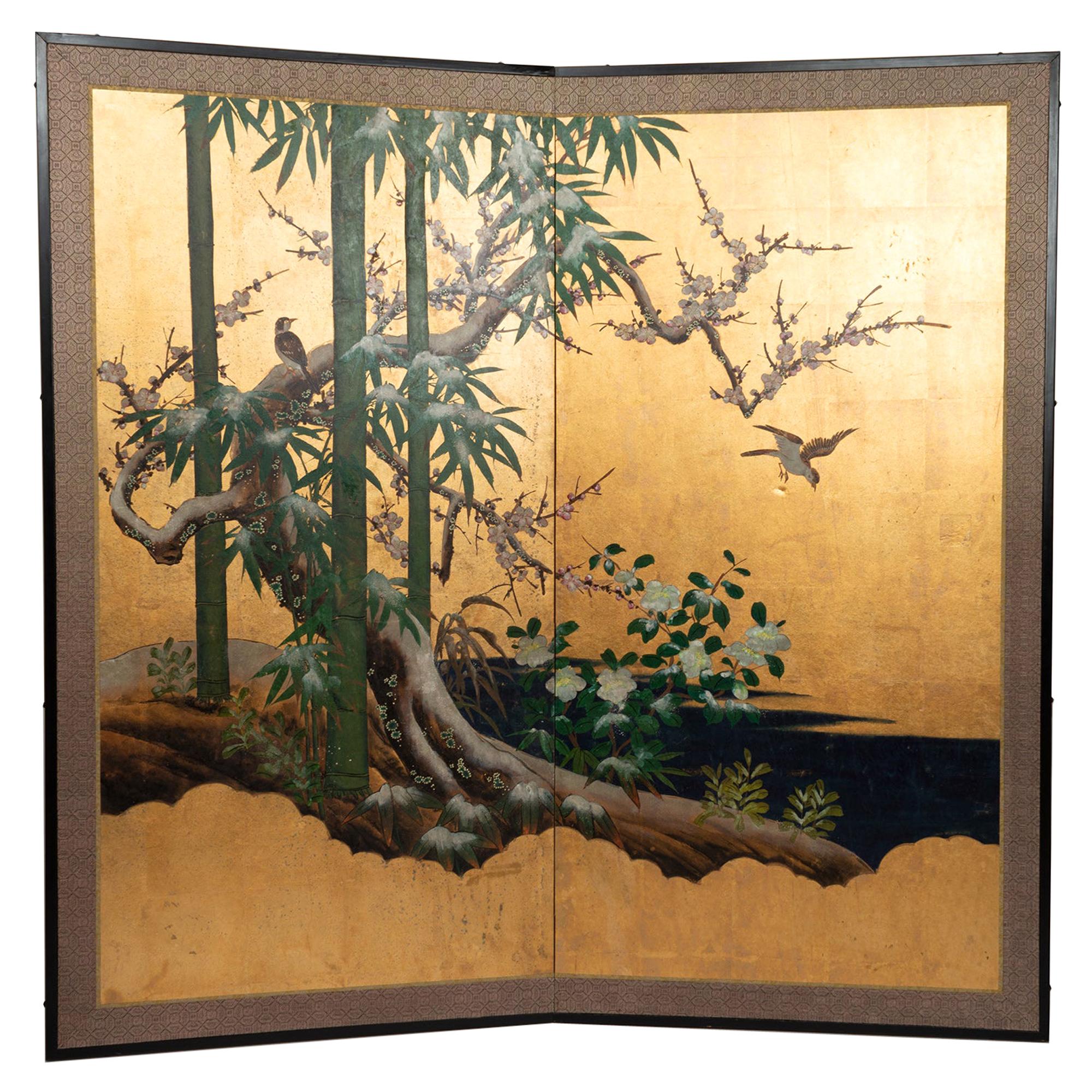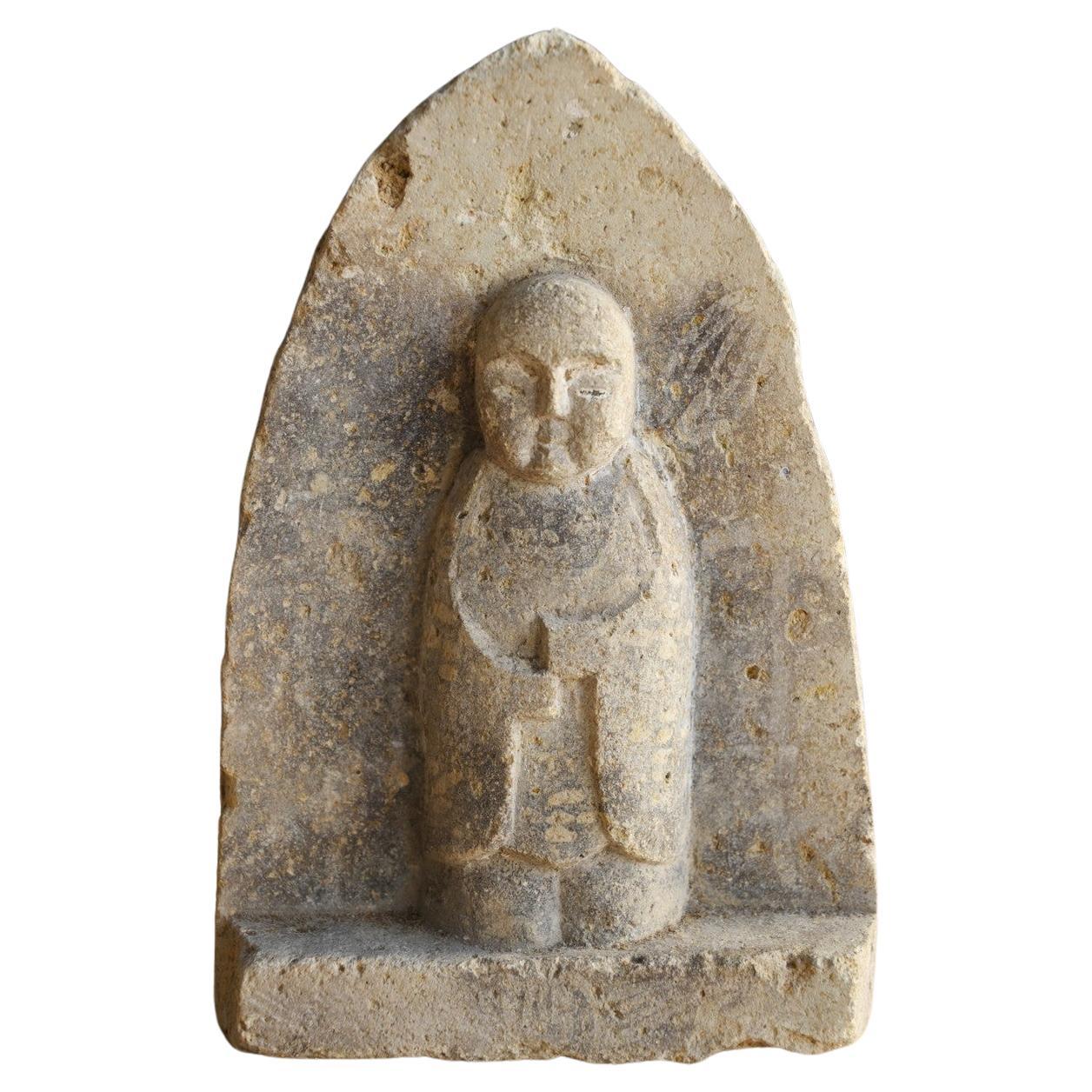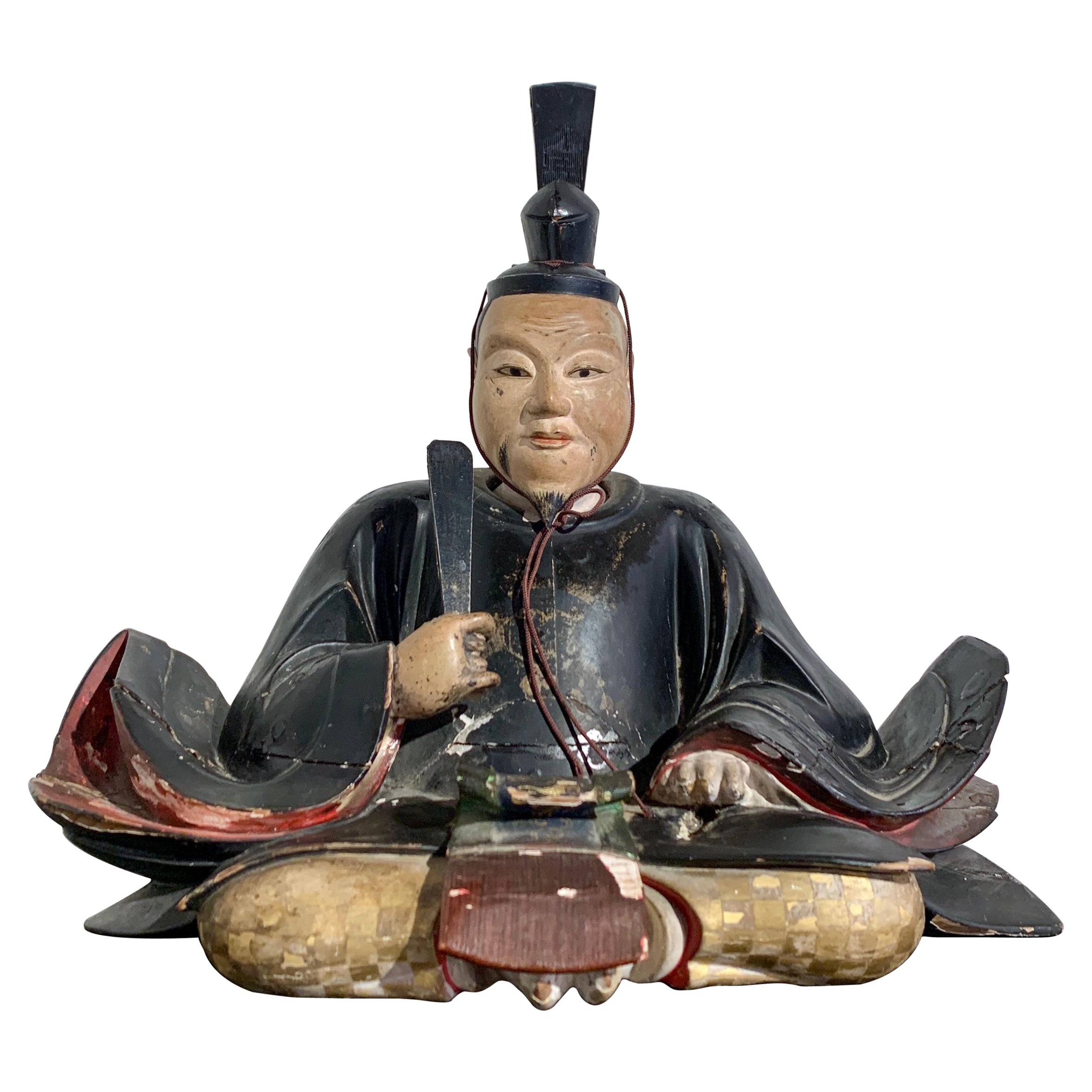Items Similar to Japanese Fine Antique Gilt Lotus Bud Flower, Edo Period 19th Century
Want more images or videos?
Request additional images or videos from the seller
Japanese Fine Antique Gilt Lotus Bud Flower, Edo Period 19th Century
About the Item
From our recent Japanese acquisitions, a rare find, stem #3
Antique Original Japanese temple "blossominig lotus" flower bud stem. This finely hand carved wood and lacquered gold flower stem was made for a Buddhist 19th century temple altar. Its flower blossoms and leaves symbolize the stages of the path toward enlightenment. The individual parts of each lotus is carved separately then joined in an arrangement and inserted in altar vessels.
This lovely Japanese antique gilt Lotus flower is an early survivor, circa 1840, and a hard to find treasure that was originally placed on or around a temple altar.
This stem consists of six (6) inidividually carved petals and one center "bud" all finely crafted, detailed, and gold lacquered. The bronze vase is contemporary.
Its attractive original old patina coupled with much of the original gilding remaining present is just the way we like to find them.
Dimensions: Height 18 inches height and 8 inches in width. The single lotus flower cluster measures 16 inches in height.
Provenance: acquired from a Kyoto Japanse monk and collector
Lifetime authenticity guarantee.
- Dimensions:Height: 18 in (45.72 cm)Width: 8 in (20.32 cm)Depth: 6 in (15.24 cm)
- Style:Edo (Of the Period)
- Materials and Techniques:
- Place of Origin:
- Period:
- Date of Manufacture:1840
- Condition:Wear consistent with age and use.
- Seller Location:South Burlington, VT
- Reference Number:1stDibs: LU1289233837282
About the Seller
5.0
Gold Seller
These expertly vetted sellers are highly rated and consistently exceed customer expectations.
Established in 1990
1stDibs seller since 2015
2,219 sales on 1stDibs
Typical response time: 1 hour
- ShippingRetrieving quote...Ships From: South Burlington, VT
- Return PolicyA return for this item may be initiated within 7 days of delivery.
More From This SellerView All
- Japanese Fine Antique Gilt and Red Lacquer Lotus Bud Flower, Edo Period 19th CLocated in South Burlington, VTFrom our recent Japanese acquisitions, a rare find Antique Original Japanese temple "blossoming lotus" flower bud stem including its original red lacquer display base. This finely hand carved wood and lacquered gold flower stem was made for a Buddhist 19th century temple altar. Its flower blossoms and leaves symbolize the stages of the path toward enlightenment. The individual parts of each lotus is carved separately then joined in an arrangement and inserted in altar vessels. Also called "Jyôka" , it is placed on or next to an altar in a Buddhist temple. Made with meticulous techniques. In Buddhism, the lotus is an important symbol of divine enlightenment because it blooms into beautiful flowers while growing in mud. Tsunehana means "a flower that continues to bloom forever" and "a flower that does not wither." For this reason, the flowers represented are in different stages of their life, unfolded lotus leaves, buds and full flowers, thus symbolizing the journey towards Buddhist enlightenment. This lovely Japanese antique gilt Lotus flower is an early survivor, circa 1840, and a hard to find treasure that was originally placed on or around a temple altar. This ensemble consists of a single stem, the top most flower, and the bottom leaf- all mounted in the original square red lacquer display base. A gold gilt 3.5 inch long tortoise "minogame" is affixed to the base as seen in the photo. Its attractive original old patina coupled with much of the original gilding remaining present is just the way we like to find them. Dimensions: With original red lacquer display stand Height, 17 inches height and 9 inches in width. The lotus flower stem alone measures 16 inches in height. Provenance: acquired from a Kyoto Japanse monk and collector History of the Japanese turtle "minogame" One of the most famous is the mythological giant turtle...Category
Antique 1840s Japanese Edo Sculptures and Carvings
MaterialsWood
- Japanese Fine Gilt Double Bouquet Lotus FlowersLocated in South Burlington, VTFrom our recent Japanese acquisitions Original Japanese temple "blossoming lotus" flower bud stems form an attractive double bouquet. Made for a shrine altar, these flower blossoms and leaves symbolize the stages of the path toward enlightenment. The individual parts of each lotus is assembled and then joined in an arrangement of two stems and two bouquets and inserted into the vessel. Called "Jyôka" and they are placed on or next to an altar in a Buddhist temple. In Buddhism, the lotus is an important symbol of divine enlightenment because it blooms into beautiful flowers while growing in mud. Tsunehana means "a flower that continues to bloom forever" and "a flower that does not wither." For this reason, the flowers represented are in different stages of their life, unfolded lotus leaves, buds and full flowers, thus symbolizing the journey towards Buddhist enlightenment. This lovely Japanese gilt Lotus...Category
Mid-20th Century Japanese Showa Sculptures and Carvings
MaterialsBronze
- Japan Fine Bronze Seated Amidha Nyorai Buddha, 19thc.Located in South Burlington, VTJapan, an elegant and fine seated Amidha Nyorai Buddha with fingers clasped in a pensive "Dhyani" Mudra pose, a superb work of art cast in bronze. It dates to the 19th century Meiji...Category
Antique 19th Century Japanese Meiji Paintings and Screens
MaterialsBronze, Copper
- Japanese Fine Antique Currency Exchange Shop Sign, Hand CarvedLocated in South Burlington, VTJapan, a beautifully handmade and hand carved black lacquer colored antique shop sign -kanban- for a Japanese currency exchange shop. The kanji translates to "currency exchange". Many antique Japanese shop signs...Category
Antique Late 19th Century Japanese Taisho Sculptures and Carvings
MaterialsWood
- Japan Fine Antique Bronze Kanon Guanyin Signed Shohei, Beautiful FaceLocated in South Burlington, VTJapan, a fine and elegant antique Kanon Guan Yin standing in a classic compassionate mudra- a superb work of art cast in solid bronze with original traces of old gold gilding. Signe...Category
Early 20th Century Japanese Taisho Paintings and Screens
MaterialsBronze
- Japanese Rare Antique Scroll of Waka Heart Poem Famous Rengetsu Otagaki, signedLocated in South Burlington, VTJapan, a rare paper scroll hand painted by renown Rengetsu Otagaki (1791-1875). She was a very famous nun in old Japan and being familiar with poetry, her Waka poems on paper, and e...Category
Antique Late 19th Century Japanese Edo Paintings and Screens
MaterialsPaper
You May Also Like
- Edo Period 19th Century Japanese Folding Screen Six Panels Flowers on Gold LeafBy Rimpa SchoolLocated in Brescia, ITClouds of gold, water and many colorful flowers: Japanese six-panel folding screen by Rimpa School. Hand painted with rice mineral pigments and inks on rice paper and gold leaf.Category
Antique Early 19th Century Japanese Edo Paintings and Screens
MaterialsGold Leaf
- Antique 19th Century Japanese Two-Panel Screen ‘Byobu’, Kano School, Edo PeriodLocated in London, GBJapanese Kano School Edo period two-panel screen depicting flowering prunus and bamboo on a rock formation, with colorful birds next to a body of water. ...Category
Antique Mid-19th Century Japanese Edo Paintings and Screens
MaterialsGold Leaf
- Japanese antique small Jizo stone Buddha/18th-19th century/Edo periodLocated in Sammu-shi, ChibaThis is a small stone Buddha made during the Edo period in Japan. His dignity is "Jizo Bodhisattva". She has a cute figure and a gentle face. It also depicts a lotus flower, with bo...Category
Antique 18th Century Japanese Edo Sculptures and Carvings
MaterialsStone
- Japanese Carved and Lacquered Wood Shogun, Edo Period, 19th Century, JapanLocated in Austin, TXAn unusual Japanese carved wood, lacquer, and gilt decorated portrait sculpture of a shogun, Edo Period, early 19th century, Japan. The unidentified shogun (possibly Tokugawa Iey...Category
Antique Mid-19th Century Japanese Edo Sculptures and Carvings
MaterialsWood, Lacquer
- Japanese Six Panel Screen with Hotei, Edo Period, Early 19th CenturyLocated in Austin, TXA delightful Japanese six panel painted paper screen featuring the beloved figure Hotei, Edo Period, early 19th century. Hotei, called Budai in China, and known as the Laughing Buddha or Fat Buddha in the West, is considered to be an emanation of Maitreya, the Buddha of the Future. In Japan, he also holds a special place as one of the Seven Lucky Gods, being the god of fortune, and protector of children. He is always portrayed as a mirthful and corpulent man, dressed in loose robes that show off his round belly. He carries a sack with him, said to be filled with treasure. As the protector of children, he is often portrayed with them playing on or around him, as he is here. The children portrayed in this screen are dressed in Chinese style clothing...Category
Antique Early 19th Century Japanese Edo Paintings and Screens
MaterialsSilk, Paper
- Flower Scene Edo Period Scroll Japan 19c Artist Kiyoshi WatanabeLocated in Amsterdam, Noord HollandAs you can see, this is an old painting by Kiyoshi Watanabe, a colored iris and a red dragonfly. It has a simple yet calm texture, and the appearance of a red dragonfly standing li...Category
Antique 18th Century Japanese Edo Paintings and Screens
MaterialsSilk
Recently Viewed
View AllMore Ways To Browse
Antique Finds
Antique Find
Gilt Flower
Flower Stems
Antique Collectors And Period Furniture
19th Century Gilt Sculpture
Antique Stage
Antique Gold Gilt Wood
Lotus Flower Furniture
Gold Japanese Flowers
Flower Bud
1840 Flowers
Carved Wood 19th Century Japanese
Lotus Bronze
Japanese Temple Sculpture
Temple Japanese Buddhist
Temple Flower
Japan Antique Wood Sculpture





